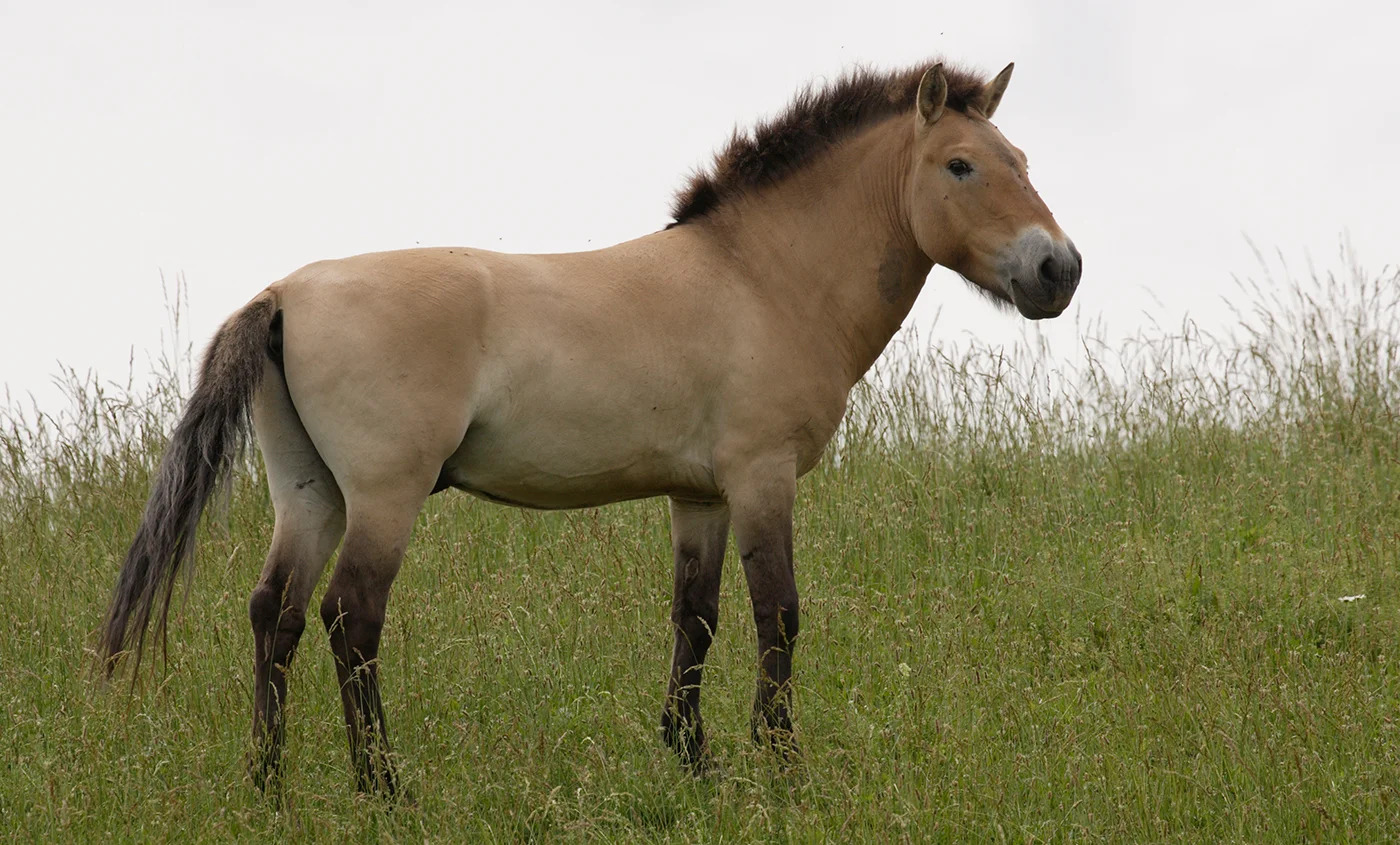
Przewalski’s Horse, scientifically known as Equus ferus przewalskii, stands as a remarkable testament to the untamed spirit of the wild. Named after the Russian explorer Nikolai Przewalski, who first described the species in 1881, this unique subspecies of wild horse has etched its place in the grassy expanses of Central Asia, particularly in Mongolia and China. With a critical endangerment status, Przewalski’s Horse has faced the challenges of habitat loss and a diminishing gene pool. However, concerted conservation efforts, spanning international collaborations and local initiatives, have fueled a promising resurgence. In this exploration, we delve into 25 historical facts and numerical trivia, uncovering the fascinating journey of Przewalski’s Horse – from its nomadic roots to the modern-day conservation endeavors that strive to ensure its enduring presence on the planet.
Scientific Name: Przewalski’s Horse, scientifically known as Equus ferus przewalskii, is a distinct subspecies of wild horse. This taxonomic classification pays homage to the Russian explorer Nikolai Przewalski, who first officially described the species in 1881. Przewalski’s Horse is the only truly wild horse species surviving today, with a unique genetic makeup that distinguishes it from domesticated horses.
Discovery: The horse’s name commemorates the Russian geographer and explorer Nikolai Przewalski, who played a pivotal role in its discovery. In the late 19th century, Przewalski led several expeditions to Central Asia, where he encountered these robust, untamed horses on the vast steppes. His detailed observations and documentation significantly contributed to our understanding of this distinct equine species.
Origins: Native to the expansive steppes of Central Asia, particularly in regions encompassing Mongolia and China, Przewalski’s Horse has adapted to survive in harsh, nomadic environments. This hardy breed has historical ties to the nomadic cultures that have roamed these vast grasslands for centuries, shaping its characteristics and resilience.
Endangered Status: Przewalski’s Horse faces a critical endangerment status, primarily due to habitat loss, competition with domesticated livestock, and a diminishing gene pool. The International Union for Conservation of Nature (IUCN) has classified it as critically endangered since the 1960s, underscoring the urgency of conservation efforts.
Conservation Efforts: In response to the alarming decline of the Przewalski’s Horse population, conservation initiatives were launched in the 1990s to reintroduce and bolster their numbers in the wild. Successful breeding programs in captivity, coupled with strategic reintroductions, have seen some progress, although challenges persist in maintaining genetic diversity.
Population Growth: As of 2022, the global population of Przewalski’s Horse is estimated to hover around 2,000 individuals. This figure represents a significant recovery from the precarious numbers of the late 20th century when the species faced the imminent threat of extinction.
Mongolian Population: Approximately 700 Przewalski’s Horses roam the vast expanses of Mongolia, where concerted conservation efforts and protected areas contribute to the preservation of this iconic species. The Mongolian government actively participates in initiatives aimed at safeguarding the wild horse population within its borders.
Appearance: Przewalski’s Horse possesses distinctive physical features, including a stocky build, dun-colored coat, erect mane, and a dark dorsal stripe along its back. These adaptations reflect the horse’s evolution to withstand the challenging climatic conditions of the Central Asian steppes.
Size: Typically standing between 12 to 14 hands (48 to 56 inches) tall at the shoulder, Przewalski’s Horse is of moderate size. This physical stature is well-suited to the species’ nomadic lifestyle, allowing it to navigate the expansive grasslands with agility and resilience.
Diet: Przewalski’s Horse sustains itself primarily as a grazer, feeding on grasses and other vegetation characteristic of the steppes. Its dietary habits are integral to the ecological balance of its habitat, contributing to the intricate web of interactions within the grassland ecosystem. Understanding and preserving these natural behaviors are crucial aspects of ongoing conservation efforts.
Social Structure: Przewalski’s Horses exhibit a social structure typically characterized by small family groups led by a dominant stallion. These family units, known as harems, consist of mares and their offspring. The dominant stallion plays a crucial role in protecting the group from potential threats and maintaining order within the social hierarchy. This structured social organization aids in the survival and cohesion of the species in the challenging steppes.
Lifespan: In the wild, Przewalski’s Horses can live up to 20 years, navigating the vast grasslands and enduring the extremes of the Central Asian climate. This lifespan is a testament to the species’ adaptability and resilience, factors that contribute to its survival in the wild.
Reproduction: The reproductive patterns of Przewalski’s Horses contribute to the species’ population dynamics. Mares typically have a gestation period of around 11 months, and they usually give birth to a single foal. This slow reproductive rate emphasizes the importance of each individual’s survival for the long-term sustainability of the population.
Habitat: Przewalski’s Horses prefer open grasslands and steppes, mirroring the vast and varied landscapes of Central Asia. Their habitat choice reflects a close ecological connection with these expansive regions, where they have evolved over millennia to thrive in the unique environmental conditions.
Domestication: Unlike many other horse breeds, Przewalski’s Horse has never been fully domesticated. This wild and untamed nature distinguishes it from its domestic counterparts and underscores its significance as a remnant of the truly wild equines that once roamed freely across the planet.
Fossil Evidence: Cave paintings and other archaeological findings provide evidence of the historical presence of Przewalski’s Horses in the Paleolithic era. These depictions offer valuable insights into the coexistence of early human societies with this iconic wild horse species.
Zoo Population: Many Przewalski’s Horses live in captivity as part of conservation and breeding programs. Zoos around the world contribute to the preservation of the species, playing a vital role in safeguarding genetic diversity and raising awareness about the challenges facing these horses in the wild.
Genetic Diversity: Studies have indicated low genetic diversity within the Przewalski’s Horse population, posing challenges for its long-term survival. Efforts to maintain and enhance genetic diversity are critical components of conservation strategies to ensure the health and adaptability of the species.
International Cooperation: Conservation efforts for Przewalski’s Horse involve collaboration between various countries, including Mongolia, China, and European nations. This international cooperation is essential for addressing the complex challenges associated with preserving a species that spans multiple borders and ecosystems.
Nomadic Culture: Przewalski’s Horse holds cultural significance in the nomadic traditions of Mongolia and Central Asia. Entwined with folklore and traditions, the horse has been an integral part of the nomadic way of life for centuries, symbolizing resilience, freedom, and the vastness of the steppes.
International Union for Conservation of Nature (IUCN): The IUCN has listed Przewalski’s Horse as critically endangered since the 1960s, highlighting the urgent need for conservation efforts. This designation serves as a rallying point for global initiatives aimed at preserving the species and its unique place in the natural world.
Mongolian Government Involvement: The Mongolian government actively participates in conservation programs to protect and sustain Przewalski’s Horse populations within its borders. This involvement reflects a commitment to preserving the country’s natural heritage and contributes to the broader global effort to safeguard the species.
Semi-Wild Populations: Some Przewalski’s Horse populations are maintained in semi-wild conditions, living in protected areas with limited human intervention. These semi-wild environments aim to strike a balance between preserving the horse’s natural behaviors and ensuring their safety from external threats.
Chernobyl Connection: In a unique initiative, a small number of Przewalski’s Horses were introduced to the Chernobyl Exclusion Zone to study their behavior in a semi-wild environment. This unconventional conservation approach provides valuable insights into the adaptability of the species and its potential role in ecosystem restoration.
Tourism Impact: Eco-tourism initiatives centered around Przewalski’s Horses contribute to local economies in Mongolia. Visitors have the opportunity to witness these majestic creatures in their natural habitat, fostering a deeper understanding of the importance of conservation and sustainable coexistence with wild species.








